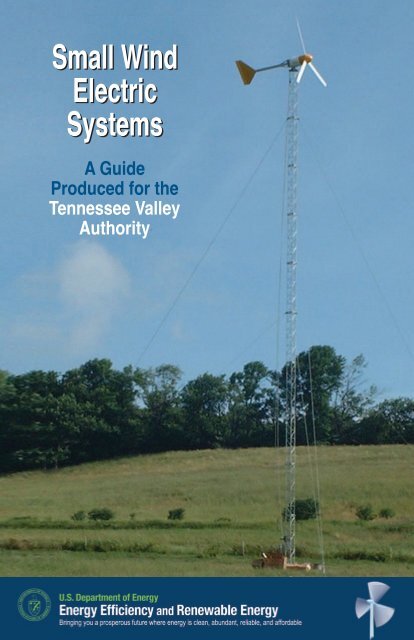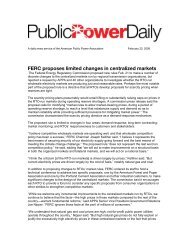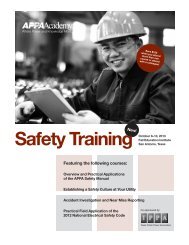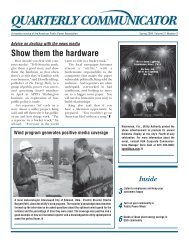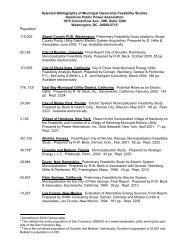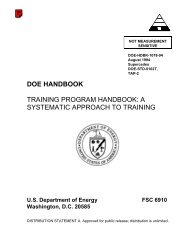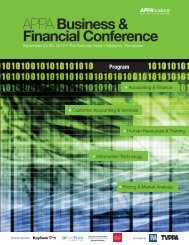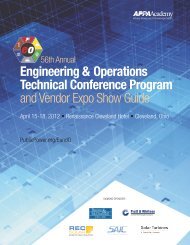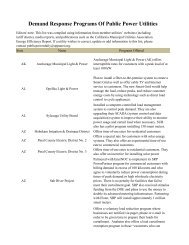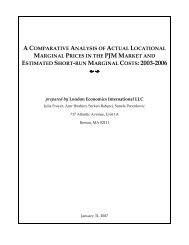Small Wind Electric Systems - American Public Power Association
Small Wind Electric Systems - American Public Power Association
Small Wind Electric Systems - American Public Power Association
You also want an ePaper? Increase the reach of your titles
YUMPU automatically turns print PDFs into web optimized ePapers that Google loves.
<strong>Small</strong> <strong>Wind</strong><strong>Electric</strong><strong>Systems</strong>A GuideProduced for theTennessee ValleyAuthority
<strong>Small</strong> <strong>Wind</strong> <strong>Electric</strong> <strong>Systems</strong>Cover photo: This 10-kW Bergey wind turbine at the Alfred State College Farm in New York providespower for the dairy farm and feeds excess energy generated into the utility grid. AWS Scientific, Inc./PIX13170.
<strong>Small</strong> <strong>Wind</strong> <strong>Electric</strong> <strong>Systems</strong> 1<strong>Small</strong> <strong>Wind</strong> <strong>Electric</strong> <strong>Systems</strong>A U.S. Consumer's GuideIntroductionCan I use wind energy to power myhome? This question is being askedacross the country as more peoplelook for affordable and reliablesources of electricity.<strong>Small</strong> wind electric systems canmake a significant contribution toour nation's energy needs. Althoughwind turbines large enough to providea significant portion of the electricityneeded by the average U.S.home generally require one acre ofproperty or more, approximately21 million U.S. homes are built onone-acre and larger sites, and 24%of the U.S. population lives in ruralareas.A small wind electric system willwork for you if:• There is enough wind where youlive• Tall towers are allowed in yourneighborhood or rural area• You have enough space• You can determine how muchelectricity you need or want toproduce• It works for you economically.The purpose of this guide is to provideyou with the basic informationabout small wind electric systems tohelp you decide if wind energy willwork for you.Why Should I Choose <strong>Wind</strong>?<strong>Wind</strong> energy systems are one of themost cost-effective home-basedrenewable energy systems.Homeowners, ranchers, and small businesses can use windgeneratedelectricity to reduce their utility bills. This gridconnectedsystem installed for a home in Norman, Oklahoma,reduces the homeowner's utility bill by $100 per month.ContentsIntroduction . . . . . . . . . . . . . . . . . . . . . . . . . . . . . . . . . . . . . .1First, How Can I Make My Home More Energy Efficient? . . . .2Is <strong>Wind</strong> Energy Practical for Me? . . . . . . . . . . . . . . . . . . . . . .3What Size <strong>Wind</strong> Turbine Do I Need? . . . . . . . . . . . . . . . . . . . .4What are the Basic Parts of a <strong>Small</strong> <strong>Wind</strong> <strong>Electric</strong> System? . .5What Do <strong>Wind</strong> <strong>Systems</strong> Cost? . . . . . . . . . . . . . . . . . . . . . . . .7Where Can I Find Installation and Maintenance Support? . . . .8How Much Energy Will My System Generate? . . . . . . . . . . . .9Is There Enough <strong>Wind</strong> on My Site? . . . . . . . . . . . . . . . . . . . .11How Do I Choose the Best Site for My <strong>Wind</strong> Turbine? . . . . .14Can I Connect My System to the Utility Grid? . . . . . . . . . . . .15Can I Go "Off-Grid"? . . . . . . . . . . . . . . . . . . . . . . . . . . . . . . .19Glossary of Terms . . . . . . . . . . . . . . . . . . . . . . . . . . . . . . . . .21For More Information . . . . . . . . . . . . . . . . . . . . . . . . . . . . . .22Bergey <strong>Wind</strong>power/PIX01476
2<strong>Small</strong> <strong>Wind</strong> <strong>Electric</strong> <strong>Systems</strong>Depending on your wind resource, asmall wind energy system can loweryour electricity bill by 50% to 90%,help you avoid the high costs ofhaving utility power lines extendedto remote locations, prevent powerinterruptions, and it is nonpolluting.How Do <strong>Wind</strong> Turbines Work?<strong>Wind</strong> is created by the unequal heatingof the Earth's surface by the sun.<strong>Wind</strong> turbines convert the kineticenergy in wind into mechanicalpower that runs a generator toproduce clean electricity. Today'sturbines are versatile modular sourcesof electricity. Their blades are aerodynamicallydesigned to capture themaximum energy from the wind. Thewind turns the blades, which spin ashaft connected to a generator thatmakes electricity.First, How Can I MakeMy Home More EnergyEfficient?Before choosing a wind system foryour home, you should considerreducing your energy consumption bymaking your home or business moreenergy efficient. Reducing yourenergy consumption will significantlylower your utility bills and willreduce the size of the home-basedrenewable energy system you need.To achieve maximum energy efficiency,you should take a wholebuildingapproach. View your homeas an energy system with interrelatedparts, all of which work synergisticallyto contribute to the efficiency ofthe system. From the insulation inyour home's walls to the light bulbs inits fixtures, there are many ways youcan make your home more efficient.• Reduce your heating and coolingneeds by up to 30% by investingjust a few hundred dollars inHome Energy UseBased on national averagesWaterheating14%Lighting,cooking,and otherappliances33%Heating andcooling44%Refrigerator 9%The largest portion of a utility bill for a typicalhouse is for heating and cooling.02979309mproper insulation andweatherization products.• Save money and increase comfortby properly maintaining andupgrading your heating,ventilation, and air-conditioningsystems.• Install double-paned, gas-filledwindows with low-emissivity(low-e) coatings to reduce heatloss in cold climates and spectrallyselective coatings to reduce heatgain in warm climates.• Replace your lights in high-useareas with fluorescents. Replacing25% of your lights can save about50% of your lighting energy bill.• When shopping for appliances,look for the ENERGY STAR® label.ENERGY STAR® appliances havebeen identified by the U.S.Environmental Protection Agencyand U.S. Department of Energyas being the most energy-efficientproducts in their classes.• For more information on how tomake your home energy efficient,see Energy Savers, in the For MoreInformation section.
6<strong>Small</strong> <strong>Wind</strong> <strong>Electric</strong> <strong>Systems</strong>maintenance on smaller light-weightturbines, usually 5 kW or less. Tiltdowntowers can also be lowered tothe ground during hazardous weathersuch as hurricanes. Aluminum towersare prone to cracking and should beavoided. Most turbine manufacturersprovide wind energy system packagesthat include towers.Mounting turbines on rooftops is notrecommended. All wind turbinesvibrate and transmit the vibrationto the structure on which they aremounted. This can lead to noise andstructural problems with the building,and the rooftop can cause excessiveturbulence that can shorten the life ofthe turbine.Balance of SystemThe parts that you need in addition tothe turbine and the tower, or the balanceof system parts, will depend onyour application. Most manufacturerscan provide you with a system packagethat includes all the parts youneed for your application. For example,the parts required for a waterpumping system will be much differentthan what you need for a residentialapplication. The balance of systemrequired will also depend on whetherthe system is grid-connected, standalone,or part of a hybrid system. Fora residential grid-connected application,the balance of system parts mayinclude a controller, storage batteries,a power conditioning unit (inverter),and wiring. Some wind turbinecontrollers, inverters, or other electricaldevices may be stamped by arecognized testing agency, likeUnderwriters Laboratories.Stand-Alone <strong>Systems</strong>Stand-alone systems (systems not connectedto the utility grid) require batteriesto store excess power generatedfor use when the wind is calm. Theyalso need a charge controller to keepthe batteries from overcharging.Deep-cycle batteries, such as thoseused for golf carts, can discharge andrecharge 80% of their capacity hundredsof times, which makes them agood option for remote renewableenergy systems. Automotive batteriesare shallow-cycle batteries and shouldnot be used in renewable energy systemsbecause of their short life indeep-cycling operations.A Bergey XL.10,10-kW wind turbineis part of a gridconnectedwind/photovoltaichybrid system thatreduces the utilitypower used by thishome in Vermont.The balance ofsystem (upper right)includes from leftto right, a Traceinverter for the PVsystem, a breakerbox, and a<strong>Power</strong>sync inverterfor the wind system.Trudy Forsyth, NREL/PIX09122 and PIX09123
<strong>Small</strong> <strong>Wind</strong> <strong>Electric</strong> <strong>Systems</strong> 7<strong>Small</strong> wind turbines generate directcurrent (DC) electricity. In very smallsystems, DC appliances operatedirectly off the batteries. If you wantto use standard appliances that useconventional household alternatingcurrent (AC), you must install aninverter to convert DC electricityfrom the batteries to AC. Althoughthe inverter slightly lowers theoverall efficiency of the system, itallows the home to be wired for AC,a definite plus with lenders, electricalcode officials, and futurehomebuyers.For safety, batteries should be isolatedfrom living areas and electronicsbecause they contain corrosiveand explosive substances. Lead-acidbatteries also require protection fromtemperature extremes.Grid-Connected <strong>Systems</strong>In grid-connected systems, the onlyadditional equipment required is apower conditioning unit (inverter)that makes the turbine output electricallycompatible with the utility grid.Usually, batteries are not needed.What Do <strong>Wind</strong> <strong>Systems</strong>Cost?A small turbine can cost anywherefrom $3,000 to $35,000 installed,depending on size, application, andservice agreements with the manufacturer.(The <strong>American</strong> <strong>Wind</strong> Energy<strong>Association</strong> [AWEA] says a typicalhome wind system costs approximately$32,000 (10 kW); a comparablephotovoltaic [PV] solar system wouldcost over $80,000.)A general rule of thumb for estimatingthe cost of a residential turbine is$1,000 to $3,000 per kilowatt. <strong>Wind</strong>energy becomes more cost effectiveas the size of the turbine’s rotorincreases. Although small turbinescost less in initial outlay, they areproportionally more expensive. Thecost of an installed residential windenergy system that comes with an80-foot tower, batteries, and inverter,typically ranges from $13,000 to$40,000 for a 3 to 10 kW wind turbine.Although wind energy systemsinvolve a significant initial investment,they can be competitive withconventional energy sources whenyou account for a lifetime of reducedor avoided utility costs. The length ofthe payback period—the time beforethe savings resulting from your systemequal the cost of the systemitself—depends on the system youchoose, the wind resource on yoursite, electricity costs in your area, andhow you use your wind system. Forexample, if you live in California andhave received the 50% buydown ofyour small wind system, have netmetering, and an average annualwind speed of 15 miles per hour(mph) (6.7 meters per second [m/s]),your simple payback would beapproximately 6 years.Southwest <strong>Wind</strong>power/PIX09156A Southwest<strong>Wind</strong>power Air303, 300 wattturbine is the solesource of electricityfor this remotehome in northernArizona.
8<strong>Small</strong> <strong>Wind</strong> <strong>Electric</strong> <strong>Systems</strong>the company's integrity and ask forreferences of past customers withinstallations similar to the one you areconsidering. Ask the system ownersabout performance, reliability, andmaintenance and repair requirements,and whether the system is meetingtheir expectations. Also, find out howlong the warranty lasts and what itincludes.<strong>Small</strong> windturbines like this10 kW BergeyXL.10 provideelectricity forhome, farm, andranch applications.Things to Consider WhenPurchasing a <strong>Wind</strong> TurbineOnce you determine you can install awind energy system in compliancewith local land use requirements, youcan begin pricing systems and components.Comparatively shop for a windsystem as you would any major purchase.Obtain and review the productliterature from several manufacturers.As mentioned earlier, lists of manufacturersare available from AWEA,(see For More Information), but notall small turbine manufacturers aremembers of AWEA. Check the yellowpages for wind energy system dealersin your area.Once you have narrowed the field,research a few companies to be surethey are recognized wind energybusinesses and that parts and servicewill be available when you needthem. You may wish to contact theBetter Business Bureau to check onWarren Gretz, NREL/PIX09615Where Can I FindInstallation andMaintenance Support?The manufacturer/dealer should beable to help you install your machine.Many people elect to install themachines themselves. Before attemptingto install your wind turbine, askyourself the following questions:• Can I pour a proper cementfoundation?• Do I have access to a lift or a way oferecting the tower safely?• Do I know the difference betweenAC and DC wiring?• Do I know enough about electricityto safely wire my turbine?• Do I know how to safely handleand install batteries?If you answered no to any of theabove questions, you should probablychoose to have your system installedby a system integrator or installer.Contact the manufacturer for helpor call your state energy office andlocal utility for a list of local systeminstallers. You can also check the yellowpages for wind energy systemservice providers. A credible installerwill provide many services such aspermitting. Find out if the installer isa licensed electrician. Ask for referencesand check them out. You mayalso want to check with the BetterBusiness Bureau.
<strong>Small</strong> <strong>Wind</strong> <strong>Electric</strong> <strong>Systems</strong> 9Although small wind turbines arevery sturdy machines, they do requiresome annual maintenance. Bolts andelectrical connections should bechecked and tightened if necessary.The machines should be checked forcorrosion and the guy wires forproper tension. In addition, youshould check for and replace anyworn leading edge tape on the blades,if appropriate. After 10 years, theblades or bearings may need to bereplaced, but with proper installationand maintenance, the machine shouldlast up to 20 years or longer.If you do not have the expertise tomaintain the machine, your installermay provide a service and maintenanceprogram.How Much Energy Will MySystem Generate?Most U.S. manufacturers rate theirturbines by the amount of power theycan safely produce at a particularwind speed, usually chosen between24 mph (10.5 m/s) and 36 mph(16 m/s). The following formulaillustrates factors that are importantto the performance of a wind turbine.Notice that the wind speed, V, has anexponent of 3 applied to it. Thismeans that even a small increase inwind speed results in a large increasein power. That is why a taller towerwill increase the productivity of anywind turbine by giving it access tohigher wind speeds as shown in the<strong>Wind</strong> Speeds Increase with Heightgraph. The formula for calculatingthe power from a wind turbine is:<strong>Power</strong> = k C p 1/2 ρ AV 3Where:P = <strong>Power</strong> output, kilowattsC p = Maximum power coefficient,ranging from 0.25 to 0.45,dimension less (theoreticalmaximum = 0.59)ρ = Air density, lb/ft 3A = Rotor swept area, ft 2 orπ D 2 /4 (D is the rotordiameter in ft, π = 3.1416)V = <strong>Wind</strong> speed, mphk = 0.000133 A constant to yieldpower in kilowatts. (Multiplyingthe above kilowatt answer by1.340 converts it to horsepower.[i.e., 1 kW = 1.340horsepower]).8Relative Size of <strong>Small</strong> <strong>Wind</strong> Turbines40Rotor Diameter, m765437 m6 m5 m4 m3 mSwept area, m 230201001 2 3 4 5 6 7Rotor Diameter, m22 m101 mSource: Paul Gipe, <strong>Wind</strong> Energy Basics02979303m
10<strong>Small</strong> <strong>Wind</strong> <strong>Electric</strong> <strong>Systems</strong>Elevation, ft10,000Air Density Change with Elevation9,0008,0007,0006,0005,0004,0003,0002,0001,000070 75 80 85 90 95 100Density change compared to sea level, %The rotor swept area, A, is importantbecause the rotor is the part of theturbine that captures the wind energy.So, the larger the rotor, the moreenergy it can capture. The air density,ρ, changes slightly with air temperatureand with elevation. The ratingsfor wind turbines are based onstandard conditions of 59° F (15° C)at sea level. A density correctionshould be made for higher elevationsas shown in the Air Density Changewith Elevation graph. A correction fortemperature is typically not neededfor predicting the long-term performanceof a wind turbine.While the calculation of wind powerillustrates important features aboutwind turbines, the best measure ofwind turbine performance is annualenergy output. The differencebetween power and energy is thatpower (kilowatts [kW]) is the rate atwhich electricity is consumed, whileenergy (kilowatt-hours [kWh]) is thequantity consumed. An estimate ofthe annual energy output from yourwind turbine, kWh/year, is the bestway to determine whether a particularwind turbine and tower will produceenough electricity to meet yourneeds.02979302mA wind turbine manufacturer can helpyou estimate the energy productionyou can expect. They will use a calculationbased on the particular windturbine power curve, the averageannual wind speed at your site, theheight of the tower that you plan touse, and the frequency distribution ofthe wind–an estimate of the numberof hours that the wind will blow ateach speed during an average year.They should also adjust this calculationfor the elevation of your site.Contact a wind turbine manufactureror dealer for assistance with thiscalculation.To get a preliminary estimate of theperformance of a particular wind turbine,use the formula below.AEO = 0.01328 D 2 V 3Where:AEO = Annual energy output,kWh/yearD = Rotor diameter, feetV = Annual average wind speed,mphThe <strong>Wind</strong> Energy Payback PeriodWorkbook found at http://www.nrel.gov/wind/ under consumer informationis a spreadsheet tool that can helpyou analyze the economics of a smallwind electric system and decidewhether wind energy will work foryou. The spreadsheet can be openedusing Microsoft Excel 95 software.It asks you to provide informationabout how you're going to finance thesystem, the characteristics of yoursite, and the properties of the systemyou're considering. It then providesyou with a simple payback estimationin years. If it takes too long to regainyour capital investment—the numberof years comes too close or is greaterthan the life of the system—windenergy will not be practical for you.
<strong>Small</strong> <strong>Wind</strong> <strong>Electric</strong> <strong>Systems</strong> 11Is There Enough <strong>Wind</strong>on My Site?Does the wind blow hard and consistentlyenough at my site to make asmall wind turbine system economicallyworthwhile? That is a key questionand not always easily answered.The wind resource can vary significantlyover an area of just a few milesbecause of local terrain influenceson the wind flow. Yet, there are stepsyou can take that will go a long waytowards answering the abovequestion.As a first step, wind resource mapslike the one on pages 12 and 13 canbe used to estimate the wind resourcein your region. The highest averagewind speeds in the United States aregenerally found along seacoasts, onridgelines, and on the Great Plains;however, many areas have windresources strong enough to power asmall wind turbine economically. Thewind resource estimates on this mapgenerally apply to terrain features thatare well exposed to the wind, such asplains, hilltops, and ridge crests. Localterrain features may cause the windresource at a specific site to differ considerablyfrom these estimates. Moredetailed wind resource information,including the <strong>Wind</strong> Energy ResourceAtlas of United States, published by theU.S. Department of Energy (DOE),can be found at the National <strong>Wind</strong>Technology Center web site athttp://www.nrel.gov/wind/ and theDOE <strong>Wind</strong>powering America website at http://www.eren.doe.gov/windpoweringamerica/.Another way to indirectly quantifythe wind resource is to obtain averagewind speed information from anearby airport. However, cautionshould be used because local terraininfluences and other factors maycause the wind speed recorded at anairport to be different from your particularlocation. Airport wind data aregenerally measured at heights about20–33 ft (6–10 m) above ground.Average wind speeds increase withheight and may be 15%–25% greaterat a typical wind turbine hub-heightof 80 ft (24 m) than those measuredat airport anemometer heights. TheNational Climatic Data Center collectsdata from airports in the United Statesand makes wind data summariesavailable for purchase. Summaries ofwind data from almost 1000 U.S. airportsare also included in the <strong>Wind</strong>Energy Resource Atlas of the UnitedStates (see For More Information).Another useful indirect measurementof the wind resource is the observationof an area’s vegetation. Trees,especially conifers or evergreens, canbe permanently deformed by strongwinds. This deformity, known as"flagging," has been used to estimatethe average wind speed for an area.For more information on the use ofTower height, ft1501209060300<strong>Wind</strong> Speeds Increase with Height0 41 75 100 124Increase in wind power, %02979308m
12 <strong>Small</strong> <strong>Wind</strong> <strong>Electric</strong> <strong>Systems</strong><strong>Small</strong> <strong>Wind</strong> <strong>Electric</strong> <strong>Systems</strong> 13
14<strong>Small</strong> <strong>Wind</strong> <strong>Electric</strong> <strong>Systems</strong>Flagging, the effectof strong winds onarea vegetation,can help determinearea wind speeds.FlaggingPrevailing wind0NodeformityIBrushingand slightflaggingIISlightflaggingIIIModerateflaggingIVCompleteflaggingVPartialthrowingVICompletethrowingVIICarpeting02979310mGriggs-Putnam Index of DeformityIndex I II III IV V VI VII<strong>Wind</strong> mph 7-9 9-11 11-13 13-16 15-18 16-21 22+Speed m/s 3-4 4-5 5-6 6-7 7-8 8-9 10flagging you may want to obtainA Siting Handbook for <strong>Small</strong> <strong>Wind</strong>Energy Conversion <strong>Systems</strong> (see ForMore Information).Direct monitoring by a wind resourcemeasurement system at a site providesthe clearest picture of the availableresource. A good overall guideon this subject is the <strong>Wind</strong> ResourceAssessment Handbook (see For MoreInformation). <strong>Wind</strong> measurement systemsare available for costs as low as$600 to $1200. This expense may ormay not be hard to justify dependingon the exact nature of the proposedsmall wind turbine system. The measurementequipment must be set highenough to avoid turbulence createdby trees, buildings, and other obstructions.The most useful readings arethose taken at hub-height, the elevationat the top of the tower where thewind turbine is going to be installed.If there is a small wind turbine systemin your area, you may be able toobtain information on the annualoutput of the system and also windspeed data if available.How Do I Choose the BestSite for My <strong>Wind</strong> Turbine?You can have varied wind resourceswithin the same property. In additionto measuring or finding out about theannual wind speeds, you need toknow about the prevailing directionsof the wind at your site. If you live incomplex terrain, take care in selectingthe installation site. If you site yourwind turbine on the top of or on thewindy side of a hill, for example, youwill have more access to prevailingwinds than in a gully or on the leeward(sheltered) side of a hill on thesame property. In addition to geologicformations, you need to considerexisting obstacles such as trees,houses, and sheds, and you need toplan for future obstructions such asnew buildings or trees that have notreached their full height. Your turbineneeds to be sited upwind of buildings
<strong>Small</strong> <strong>Wind</strong> <strong>Electric</strong> <strong>Systems</strong> 15Obstruction of the <strong>Wind</strong> by a Buildingor Tree of Height (H)HRegionof highlyturbulentflow2 H02979307m2 Hand trees, and it needs to be 30 feetabove anything within 300 feet. Youalso need enough room to raise andlower the tower for maintenance, andif your tower is guyed, you mustallow room for the guy wires.Whether the system is stand-aloneor grid-connected, you will also needto take the length of the wire runbetween the turbine and the load(house, batteries, water pumps, etc.)into consideration. A substantialamount of electricity can be lost as aresult of the wire resistance—thelonger the wire run, the more electricityis lost. Using more or larger wirewill also increase your installationcost. Your wire run losses are greaterwhen you have direct current (DC)instead of alternating current (AC).So, if you have a long wire run, it isadvisable to invert DC to AC.Can I Connect My Systemto the Utility Grid?<strong>Small</strong> wind energy systems can beconnected to the electricity distributionsystem and are called gridconnectedsystems. A grid-connectedwind turbine can reduce your consumptionof utility-supplied electricityfor lighting, appliances, andelectric heat. If the turbine cannotdeliver the amount of energy you20 Hneed, the utility makes up the difference.When the wind system producesmore electricity than the householdrequires, the excess is sent or sold tothe utility.Grid-connected systems can be practicalif the following conditions exist:• You live in an area with averageannual wind speed of at least10 mph (4.5 m/s).• Utility-supplied electricity isexpensive in your area (about 10 to15 cents per kilowatt-hour).• The utility's requirements forconnecting your system to its gridare not prohibitively expensive.• There are good incentives for thesale of excess electricity or for thepurchase of wind turbines.Federal regulations (specifically, the<strong>Public</strong> Utility Regulatory Policies Actof 1978, or PURPA) require utilitiesto connect with and purchase powerfrom small wind energy systems.However, you should contact yourutility before connecting to their distributionlines to address any powerquality and safety concerns. Yourutility can provide you with a list ofrequirements for connecting your systemto the grid. The <strong>American</strong> <strong>Wind</strong>Energy <strong>Association</strong> is another goodsource for information on utilityThe farther youplace your windturbine fromobstacles suchas buildings ortrees, the lessturbulence youwill encounter.
16<strong>Small</strong> <strong>Wind</strong> <strong>Electric</strong> <strong>Systems</strong>A grid-connectedwind turbine canreduce yourconsumption ofutility-suppliedelectricity.Grid-connected <strong>Systems</strong>InverterACMeter<strong>Wind</strong>turbineLoad02979301minterconnection requirements. Thefollowing information about utilitygrid connection requirements wastaken from AWEA's Web site. Formore detailed information, visithttp://www.awea.org/ or contactAWEA (see For More Information).Net MeteringThe concept of net metering programsis to allow the electric meters of customerswith generating facilities toturn backwards when their generatorsare producing more energy than thecustomers’ demand. Net meteringallows customers to use their generationto offset their consumption overthe entire billing period, not justinstantaneously. This offset wouldenable customers with generatingfacilities to receive retail prices formore of the electricity they generate.Net metering varies by state and byutility company, depending onwhether net metering was legislatedor directed by the <strong>Public</strong> UtilityCommission. Net metering programsall specify a way to handle the netexcess generation (NEG) in terms ofpayment for electricity and/or lengthof time allowed for NEG credit. If thenet metering requirements defineNEG on a monthly basis, the consumercan only get credit for theirexcess that month. But if the netmetering rules allow for annual NEG,the NEG credit can be carried for upto a year.Most of North America gets morewind in the winter than in the summer.For people using wind energy todisplace a large load in the summerlike air-conditioning or irrigationwater pumping, having an annualNEG credit allows them to produceNEG in the winter and be credited inthe summer.Safety RequirementsWhether or not your wind turbine isconnected to the utility grid, theinstallation and operation of the windturbine is probably subject to the electricalcodes that your local government(city or county) or in someinstances your state government hasin place. The government’s principalconcern is with the safety of thefacility, so these code requirementsemphasize proper wiring and installation,and the use of componentsthat have been certified for fire andelectrical safety by approved testinglaboratories, such as UnderwritersLaboratories. Most local electricalcodes requirements are based on theNational <strong>Electric</strong>al Code (NEC),which is published by the NationalFire Protection <strong>Association</strong>. As of1999, the latest version of the NEC didnot have any sections specific to theinstallation of wind energy facilities,
<strong>Small</strong> <strong>Wind</strong> <strong>Electric</strong> <strong>Systems</strong> 17consequently wind energy installationsare governed by the genericprovisions of the NEC.If your wind turbine is connected tothe local utility grid so that any of thepower produced by your wind turbineis delivered to the grid, then yourutility also has legitimate concernsabout safety and power quality thatneed to be addressed. The utility’sprincipal concern is that your windturbine automatically stops deliveringany electricity to its power lines duringa power outage. Otherwise lineworkers and the public, thinking thatthe line is "dead," might not take normalprecautions and might be hurt oreven killed by the power from yourturbine. Another concern among utilitiesis that the power from your facilitysynchronize properly with theutility grid, and that it match the utility’sown power in terms of voltage,frequency, and power quality.A few years ago, some state governmentsstarted developing newstandardized interconnection requirementsfor small renewable energygenerating facilities (including windturbines). In most cases the newrequirements have been based on consensus-basedstandards and testingprocedures developed by independentthird-party authorities, such as theInstitute of <strong>Electric</strong>al and ElectronicEngineers and UnderwritersLaboratories.agreement with each company.Usually these agreements are writtenby the utility or the electricityprovider. In the case of private(investor-owned) utilities, the termsand conditions in these agreementsmust be reviewed and approved bystate regulatory authorities.InsuranceSome utilities require small windturbine owners to maintain liabilityinsurance in amounts of $1 million ormore. Utilities consider these requirementsare necessary to protect themfrom liability for facilities they do notown and have no control over. Othersconsider the insurance requirementsexcessive and unduly burdensome,making wind energy uneconomic. Inthe 21 years since utilities have beenrequired to allow small wind systemsto interconnect with the grid therehas never been a liability claim, letalone a monetary award, relating toelectrical safety.This gridconnected,10 kW Bergeywind turbineoffsets electricalpowerconsumption fora small businessin Norman,Oklahoma.Interconnection RequirementsMost utilities and other electricityproviders require you to enter into aformal agreement with them beforeyou interconnect your wind turbinewith the utility grid. In states thathave retail competition for electricityservice (e.g., your utility operatesthe local wires, but you have achoice of electricity provider)you may have to sign a separateBergey <strong>Wind</strong>power/PIX07166
18<strong>Small</strong> <strong>Wind</strong> <strong>Electric</strong> <strong>Systems</strong>In six states (California, Maryland,Nevada, Oklahoma, Oregon, andWashington), laws or regulatoryauthorities prohibit utilities fromimposing any insurance requirementson small wind systems that qualify for"net metering." In at least three otherstates (Idaho, New York, Virginia) regulatoryauthorities have allowed utilitiesto impose insurance requirements,but have reduced the required coverageamounts to levels consistent withconventional residential or commercialinsurance policies (e.g., $100,000to $300,000). If your insuranceamounts seem excessive, you can askfor a reconsideration from regulatoryauthorities (in the case of privateinvestor-owned utilities) or to theutility’s governing board (in the caseof publicly-owned utilities).IndemnificationAn indemnity is an agreementbetween two parties where one agreesto secure the other against loss ordamage arising from some act orsome assumed responsibility. Inthe context of customer-ownedgenerating facilities, utilities oftenwant customers to indemnify themfor any potential liability arising fromthe operation of the customer’s generatingfacility. Although the basic principleis sound—utilities should not beheld responsible for property damageor personal injury attributable tosomeone else—indemnity provisionsshould not favor the utility but shouldbe fair to both parties. Look for languagethat says, "each party shallindemnify the other . . ." rather than"the customer shall indemnify theutility . . ."Customer ChargesCustomer charges can take a varietyof forms, including interconnectioncharges, metering charges, andstandby charges, among others. Youshould not hesitate to question anycharges that seem inappropriate toyou. Federal law (<strong>Public</strong> UtilityRegulatory Policies Act of 1978, orPURPA, Section 210) prohibits utilitiesfrom assessing discriminatory chargesto customers who have their owngeneration facilities.Warren Gretz, NREL/PIX09634Connecting to the Utility Grid—A Success StoryThis 10-kW Bergey wind turbine, installed on afarm located in Southwestern Kansas in 1983,produces an average 1700–1800 kilowatt-hoursper month, reducing the user's monthly utilitybills by approximately 50%. The turbine costabout $20,000 when it was installed. Since then,the cost for operation and maintenance has beenabout $50 per year. The only unscheduled maintenanceactivity over the years was repair to theturbine required as a result of damage caused bya lightning strike. Insurance covered all but $500of the $9000 cost of damages. The basic systemparts include:Bergey XL.10 wind turbine100-foot free-standing lattice towerInverter
<strong>Small</strong> <strong>Wind</strong> <strong>Electric</strong> <strong>Systems</strong> 19Hybrid <strong>Power</strong> <strong>Systems</strong>Combine multiple sources to deliver non-intermittent electric powerPV modulesA hybrid systemthat combines awind system with asolar and/or dieselgenerator canprovide reliable offgridpower aroundthe clock.Generator<strong>Wind</strong>turbineRegulation andconversionAC orDCLoad02979301mBattery bankCan I Go "Off-Grid"?Hybrid <strong>Systems</strong>Hybrid wind energy systems canprovide reliable off-grid power forhomes, farms or even entire communities(a co-housing project, forexample) that are far from the nearestutility lines. According to manyrenewable energy experts, a "hybrid"system that combines wind andphotovoltaic (PV) technologies offersseveral advantages over either singlesystem. In much of the United States,wind speeds are low in the summerwhen the sun shines brightest andlongest. The wind is strong in thewinter when there is less sunlightavailable. Because the peak operatingtimes for wind and PV occur at differenttimes of the day and year, hybridsystems are more likely to producepower when you need it. (For moreinformation on solar electric orPV systems, contact the EnergyEfficiency and Renewable EnergyClearinghouse—see For MoreInformation.)For the times when neither the windnor the PV modules are producing,most hybrid systems provide powerthrough batteries and/or an enginegeneratorpowered by conventionalfuels such as diesel. If the batteriesrun low, the engine-generator canprovide power and recharge the batteries.Adding an engine-generatormakes the system more complex, butmodern electronic controllers canoperate these systems automatically.An engine-generator can also reducethe size of the other componentsneeded for the system. Keep in mindthat the storage capacity must belarge enough to supply electricalneeds during non-charging periods.Battery banks are typically sized tosupply the electric load for one tothree days.An off-grid hybrid system may bepractical for you if:• You live in an area with averageannual wind speed of at least9 mph (4.0 m/s).• A grid connection is not availableor can only be made through an
20<strong>Small</strong> <strong>Wind</strong> <strong>Electric</strong> <strong>Systems</strong>expensive extension. The cost ofrunning a power line to a remotesite to connect with the utility gridcan be prohibitive, ranging from$15,000 to more than $50,000 permile, depending on terrain.• You would like to gain energyindependence from the utility.• You would like to generate cleanpower.Living Off-Grid—A Success StoryThis home, built near in Ward, Colorado (at an elevation of 9000 feet), hasbeen off-grid since it was built in 1972. When the house was built, the nearestutility was over a mile away, and it would have cost between $60K–$70K(based on 1985 rates) to connect to the utility lines. The owners decided toinstall a hybrid electric system poweredby wind, solar, and a generator for a costof about $19,700. The parts of the systeminclude:Bergey 1.5 kW wind turbine, 10-ft (3-m)diameter rotor, 70-ft. (21-m) towerSolarex PV panels, 480 watts24 DC battery bank, 375 ampere-hoursTrace sine wave inverter, 120 AC, 1 phase,4 kWOnan propane-fueled generator, 6.5 kWrated (3 kW derated for altitude)<strong>Electric</strong> appliances in the home includetelevision, stereo, two computers, toaster,blender, vacuum cleaner, and hair dryer.The largest electric loads are created bya well pump and washing machine. Thegenerator runs about 20% of the time,particularly when the washing machineis in use. Propane serves the other majorloads in the home: range, refrigerator, hotwater, and space heat. Solar collectors onthe roof provide pre-heating for the hotwater.Jim Green, NREL/PIX02796
<strong>Small</strong> <strong>Wind</strong> <strong>Electric</strong> <strong>Systems</strong> 21Glossary of TermsAirfoil—The shape of the blade crosssection,which for most modern horizontalaxis wind turbines, is designedto enhance the lift and improve turbineperformance.Ampere-hour—A unit of for the quantityof electricity obtained by integratingcurrent flow in amperes over thetime in hours for its flow; used as ameasure of battery capacity.Anemometer—A device to measurethe wind speed.Average wind speed—The mean windspeed over a specified period of time.Blades—The aerodynamic surfacethat catches the wind.Brake—Various systems used to stopthe rotor from turning.Converter—See Inverter.Cut-in wind speed—The wind speedat which a wind turbine begins togenerate electricity.Cut-out wind speed—The wind speedat which a wind turbine ceases togenerate electricity.Density—Mass per unit of volume.Downwind—On the opposite sidefrom the direction from which thewind is blowing.Furling—A passive protection for theturbine where typically the rotor foldseither up or around the tail vane.Grid—The utility distribution system.The network that connects electricitygenerators to electricity users.HAWT—Horizontal axis wind turbine.Inverter—A device that converts directcurrent (DC) to alternating current(AC).kW—Kilowatt, a measure of powerfor electrical current (1000 watts).kWh—Kilowatt-hour, a measureof energy equal to the use of onekilowatt in one hour.MW—Megawatt, a measure of power(1,000,000 watts).Nacelle—The body of a propeller-typewind turbine, containing the gearbox,generator, blade hub, and other parts.O&M Costs—Operation and maintenancecosts.<strong>Power</strong> Coefficient—The ratio of thepower extracted by a wind turbineto the power available in the windstream.<strong>Power</strong> curve—A chart showing awind turbine's power output acrossa range of wind speeds.PUC—<strong>Public</strong> Utility Commission, astate agency which regulates utilities.In some areas known as <strong>Public</strong> ServiceCommission (PSC).PURPA—<strong>Public</strong> Utility RegulatoryPolicies Act (1978), 16 U.S.C. § 2601.18CFR §292 that refers to smallgenerator utility connection rules.Rated output capacity—The outputpower of a wind machine operatingat the rated wind speed.Rated wind speed—The lowest windspeed at which the rated outputpower of a wind turbine is produced.Rotor—The rotating part of a windturbine, including either the bladesand blade assembly or the rotatingportion of a generator.Rotor diameter—The diameter of thecircle swept by the rotor.Rotor speed—The revolutions perminute of the wind turbine rotor.Start-up wind speed—The wind speedat which a wind turbine rotor willbegin to spin. See also cut-in windspeed.
22<strong>Small</strong> <strong>Wind</strong> <strong>Electric</strong> <strong>Systems</strong>Swept area—The area swept by theturbine rotor, A = πR 2 , where R is theradius of the rotor.Tip speed ratio—The speed at the tipof the rotor blade as it moves throughthe air divided by the wind velocity.This is typically a design requirementfor the turbine.Turbulence—The changes in windspeed and direction, frequentlycaused by obstacles.Upwind—On the same side as thedirection from which the wind isblowing—windward.VAWT—Vertical axis wind turbine.<strong>Wind</strong> farm—A group of wind turbines,often owned and maintained byone company. Also known as a windpower plant.Yaw—The movement of the tower topturbine that allows the turbine to stayinto the wind.For More InformationBooksA Siting Handbook for <strong>Small</strong> <strong>Wind</strong>Energy Conversion <strong>Systems</strong>. H. Wegley,J. Ramsdell, M. Orgill and R. Drake,Report No. PNL-2521 Rev.1, 1980;available from National TechnicalInformation Service, 5285 Port RoyalRd., Springfield, VA 22151.(800) 553-6847. http://www.ntis.gov/ordering.htmEnergy Savers Tips on Saving Energyand Money at Home—A consumer'sguide for saving energy and reducingutility bills. Available from U.S.Department of Energy's EnergyEfficiency and Renewable EnergyClearinghouse (EREC), P.O. Box 3048,Merrifield, Virginia 22116. (800)363-3732. http://www.eren.doe.gov/consumerinfo/energy_savers.<strong>Wind</strong> Energy Basics by Paul Gipe—Acomprehensive guide to modern smallwind technology. Available throughAWEA. (202) 383-2500. http://www.awea.org and Chelsea GreenPublishing Company, White RiverJunction, Vermont. 1999. ISBN1-890132-07-01. http://www.chelseagreen.com<strong>Wind</strong> Energy Resource Atlas of theUnited States by D. Elliott et al.Available from the <strong>American</strong> <strong>Wind</strong>Energy <strong>Association</strong>, 122 C. StreetN.W., Washington D.C. 20001.http://rredc.nrel.gov/wind/pubs/atlas<strong>Wind</strong> <strong>Power</strong> for Home and Business byPaul Gipe—A comprehensive guideto modern small wind technology.Available through AWEA. (202) 383-2500. http://www.awea.org andChelsea Green Publishing Company,White River Junction, Vermont. 1999.ISBN - 0-930031-64-4. http://www.chelseagreen.com<strong>Wind</strong> <strong>Power</strong> Workshop by HughPiggott—Provides an overview onhow to design a home-built wind turbine.Available from The Center forAlternative Technology, Machynlleth,Powys, SY20 9AZ, UK Phone: 06154-702400, FAX: 01654 702782. E-mail:help@catinfo.demon.co.uk,http://www.foe.co.uk/CAT<strong>Wind</strong> Resource Assessment Handbook:Fundamentals for Conducting aSuccessful Monitoring Program—Thishandbook presents industry-acceptedguidelines for planning and conductinga wind resource measurementprogram. These guidelines, which aredetailed and highly technical, emphasizethe tasks of selecting, installing,and operating wind measurementequipment, as well as collecting andanalyzing the associated data.Prepared by AWS Scientific, Inc.Available electronically in NREL'spublication database at http://www.nrel.gov/publications.
<strong>Small</strong> <strong>Wind</strong> <strong>Electric</strong> <strong>Systems</strong> 23Government AgenciesEnergy Efficiency and RenewableEnergy Clearinghouse, P.O. Box 3048,Merrifield, Virginia 22116 800-DOE-EREC (363-3732). http://www.eren.doe.govNational Climatic Data Center,Federal Building, 151 Patton Avenue,Asheville, North Carolina, 28801-5001.(828) 271-4800. Fax (828) 271-4876.http://www.ncdc.noaa.govU.S. Department of Commerce,National Technical InformationService, 5285 Port Royal Road,Springfield, Virginia 22161. (800)553-6847. http://www.ntis.gov/ordering.htmNon-Government Organizations<strong>American</strong> <strong>Wind</strong> Energy <strong>Association</strong>,122 C Street, N.W. 4 th Floor,Washington, D.C. 20001. (202) 383-2500. http://www.awea.orgSolar Energy International—Shortcourses on renewable energy andsustainable development, inCarbondale, Colorado. (970) 963-8855.http://www.solarenergy.orgPeriodicals"Apples and Oranges" by MickSagrillo—A comprehensive comparisonof available small wind turbines.On Home <strong>Power</strong> Magazine Web site:http://www.homepower.comHome <strong>Power</strong> Magazine—The definitivebimonthly magazine for thehomemade power enthusiast.(800)707-6586 or on the Web at:http://www.homepower.comsystems. Order from AWEA (202) 383-2500, http://www.awea.orgWeb SitesAWEA <strong>Small</strong> <strong>Wind</strong> <strong>Systems</strong> Website—Includes answers to frequentlyasked questions and information onU.S. manufacturers. http://www.awea.org/smallwind.htmlDatabase of State Incentives forRenewable Energy—On the Web athttp://www.dcs.ncsu.edu/solar/dsire/dsire.htmlGreen <strong>Power</strong> Network Net MeteringWeb Site—Net metering programs arenow available in 30 states. Visit thisDOE Web site for information:http://www.eren.doe.gov/greenpower/netmetering<strong>Small</strong> <strong>Wind</strong> "Talk" on the Web—AWEA's Home Energy <strong>Systems</strong> electronicmailing list is designed as aforum for the discussion of small-scaleenergy systems that include wind. Tosubscribe, send a subscription requestawea-wind-home-subscribe@egroups.com.<strong>Wind</strong> Energy for Homeowners—ThisWeb site discusses things you shouldconsider before investing in a smallwind energy system and providesbasic information about the systems.http://www.eren.doe.gov/wind/homeowner.htmlVideosAn Introduction to Residential <strong>Wind</strong><strong>Systems</strong> with Mick Sagrillo—A 63-minute video answering questionsmost often asked by homeownersas they consider purchasing andinstalling their own wind power
24<strong>Small</strong> <strong>Wind</strong> <strong>Electric</strong> <strong>Systems</strong>2002 Farm Bill — <strong>Wind</strong>Energy DevelopmentProvisionsRenewable Energy <strong>Systems</strong> andEnergy Efficiency ImprovementsIncentive Type: Low-interest loans, loanguarantees, and grantsEligible Technologies: Renewable energysystems (energy derived from wind,solar, biomass, geothermal, and hydrogenderived from biomass or waterusing a renewable energy source) andenergy efficiency improvementsApplicable Sectors: Agriculture, rural,small commercialAmount: Varies. The grant may not exceed25% of the cost of a project, and a combinedgrant and loan or guarantee maynot exceed 50% of the cost of a project.Terms: 2003 – 2007Date Enacted: 2002Authority: Farm Bill, Title IX, Section 9006Summary: This law allows direct financialassistance to farmers, ranchers, and ruralsmall businesses for the purchase of windpower and other renewable energy systemsand for energy efficiency improvements.This program is authorized forfunding for up to $23,000,000 per year in2003-2007, totaling up to $115 million. Indetermining the amount of a grant or loan,USDA shall consider the type of renewableenergy system, the quantity of energy likelyto be generated, the expected environmentalbenefits, the extent to which the systemis replicable, and the amount of energysavings from energy efficiency improvementsand the likely payback period.USDA Rural Development State Officecontacts can be found at www.rurdev.usda.gov/rbs/farmbill/contacts.htm.USDA Farm Bill Web site: www.rurdev.usda.gov/rbs/farmbill.Green Tags<strong>Wind</strong> energy systems generate bothelectricity and environmental attributes(emission savings from not burning fossilfuels). These environmental attributesare a product that some consumers areinterested in purchasing. Green tags canbe sold to marketing entities who willthen aggregate them and resell them toconsumers.The Green-e Web site below includes a listof companies that might be interested inpurchasing green tags, by virtue of the factthat they sell such tags. In addition,Mainstay Energy purchases green tagsfrom smaller-scale renewable energysystems, and Evolution Markets sellsenvironmental attributes in the formof Renewable Energy Credits.Contacts:Green-e(888) 634-7336green-e.org/your_e_choices/trcs.htmlMainstay Energy(877) 473-3682info@mainstayenergy.comwww.mainstayenergy.comEvolution Markets(914) 323-0200agiovinetto@evomarkets.com
<strong>Small</strong> <strong>Wind</strong> <strong>Electric</strong> <strong>Systems</strong>Tennessee Valley Authority (TVA) IncentivesTVA — Green <strong>Power</strong> Switch® GenerationPartners ProgramTVA and participating power distributors currentlyoffer a dual metering option to residential and smallcommercial consumers (non-demand metered)through the Green <strong>Power</strong> Switch® GenerationPartners Program. The output (green power)generated from this program will be counted asa TVA Green <strong>Power</strong> Switch resource.Through this program, TVA will purchase the entireoutput of a qualifying system ($0.15 per kWh)through a participating power distributor, and thesystem owner will receive a credit for the powergenerated. Participation in this program is entirelyat the discretion of the power distributor. Until atotal capacity of 150 kW has been reached, theowner of a qualifying residential system will receivea $500 payment (only one $500 payment per site)when the site is connected to the grid. The credit of$0.15/kWh is available for a minimum of 10 yearsfrom the signing of the contract, regardless of theamount produced.Qualifying sources include wind turbine systems witha minimum output of 500 W AC and a maximum of50 kW. Qualifying systems must be used primarily toprovide all or part of the energy needs at a particularsite and must not have previously generated powerfor the grid. Installations must also comply with localcodes and adhere to specific interface guidelinesestablished by the program.Participating <strong>Power</strong> Distributors include:Caney Fork <strong>Electric</strong> Cooperative, McMinnville,Tennessee; Dickson <strong>Electric</strong> Department, Dickson,Tennessee; Harriman Utility Board, Harriman,Tennessee; Lenoir City Utilities Board, Lenoir City,Tennessee; Prentiss County <strong>Electric</strong> <strong>Power</strong><strong>Association</strong>, Booneville, Mississippi; and SevierCounty <strong>Electric</strong> System, Sevierville, Tennessee.For more information, go to www.tva.com/greenpowerswitch/partners/index.htm.Contact:Gary HarrisTennessee Valley AuthorityGreen <strong>Power</strong> Switch®P.O. Box 292409, OCP- 2E-400Nashville, TN 37229-2409Phone: (615) 232-6124Fax: (615) 232-6038E-mail: ghharris@tva.govWeb site: www.tva.com/greenpowerswitch/There are seven states in TVA’s power serviceterritory, including Alabama, Georgia, Kentucky,Mississippi, North Carolina, Tennessee, and Virginia.Information on incentives for small wind projectsin any of these states can be found by going toThe Database of State Incentives for RenewableEnergy (DSIRE), which can be accessed at www.dsireusa.org. DSIRE is a comprehensive source ofinformation on state, local, utility, and selected federalincentives that promote renewable energy.
Other ContactsDwight BaileyU.S. Department of EnergyAtlanta Regional Office75 Sprint Street, S.W.Atlanta, GA 30303-3308Phone: (404) 562-0564Fax: (404) 562-0538E-mail: Dwight.Bailey@hq.doe.govWeb site: www.eere.energy.gov/aro<strong>Wind</strong> <strong>Power</strong>ing Americawww.windpoweringamerica.govA Strong Energy Portfolio for a Strong AmericaEnergy efficiency and clean, renewable energy will mean a stronger economy, a cleaner environment, and greater energyindependence for America. Working with a wide array of state, community, industry, and university partners, the U.S.Department of Energy’s Office of Energy Efficiency and Renewable Energy invests in a diverse portfolio of energy technologies.Produced for the U.S. Department of Energy by theNational Renewable Energy Laboratory,a DOE national laboratoryDOE/GO-102004-1897 • May 2004For more information contact:EERE Information Center1-877-EERE-INF (1-877-337-3463)www.eere.energy.govPrinted with a renewable-source ink on paper containing at least 50% wastepaper, including 20% postconsumer waste.


